 World TRIZ-related Sites Project (WTSP) (A4) World TRIZ-related Sites Project (WTSP) (A4) |
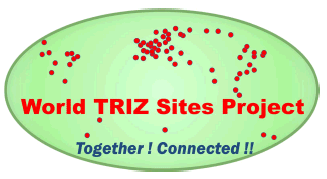

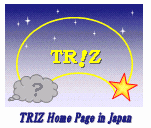 
|
(A4) Guidelines for Building World WTSP Catalogs (New) |
Editor: Toru Nakagawa (WTSP Project Leader, Osaka Gakuin Univ.),
Dec. 21, 2017; Latest Update: Nov. 20, 2020 |
The old page has been Archived: Old A  (Mar. 31, 2020) (Mar. 31, 2020)
|
Original version: Posted: Dec. 27, 2017; Last updated: Aug. 24, 2019;
New version: Posted Apr. 4, 2020;
Updated: May 14; Jun. 30; Nov. 22, 2020;
May 7, 2021
|
For going to Japanese pages, press  buttons.
buttons.
 Editor's Note (Toru Nakagawa, Apr. 1, 2020)
Editor's Note (Toru Nakagawa, Apr. 1, 2020)
This page has been renewed. See the Old page in the Archive (Old A) 
 Editor's Note (Toru Nakagawa, Mar. 28, 2020)
Editor's Note (Toru Nakagawa, Mar. 28, 2020)
This page shows the Guidelines for building the documents in WTSP in its up-to-date form.
Please note that some formalities (written mostly from Dec. 2017 to Jun. 2019) are already released to be more practical, as shown here.
(0) Summary of Practice Guide to Build and Enhance the World WTSP Catalogs 
(A) Practice Guide for Building Country/Methodology Parts of the World WTSP Catalogs:
For Teams of countries and SIGs (Special Interest Groups) of various methodologies 
(1) Any person who understands the significance of the WTSP Project may voluntarily join WTSP as a member. 
(2) List up Web sites related to TRIZ in each country (or in the specific methodology). 
(3) Describe the basic information and (brief/standard/close) introduction of each site. 
Basic information is the items to be used in the Index Table of sites.
(3a) Brief introduction (3 - 10 lines) in a free format by a surveyor (WTSP Member/Supporter) by actually visiting the site.
(3b) Introduction in the WTSP Standard Form (1 page in A4) by the site owner. This is requested for all the sites in the World WTSP Catalogs.
(3c) Optional close Introduction in free format (2 - 5 pages or more in A4) written by the site owner, in addition to (3b).
(4) Evaluate each site (tentatively) using five grades: ◎〇□△ー. 
(5) Make a Table ('Index Table') of sites with basic information for indexing. (.xlsx) 
(6) Make these manuscripts (3) (5) open for review and revision in the country (or among people interested in the methodology), by forming cooperative (Country) Team / (SIG) Group . of WTSP Members and Supporters with voluntary coordinators. 
(7) Convert these manuscripts into HTML pages, and Make Country/Methodology Part of WTSP Catalog. 
(8) Submit the completed manuscript of the Country/Methodology Part of WTSP Catalog (with the evaluation levels ◎〇□) to the Project Leader. 
(9) Review the World WTSP Catalogs and adjust/revise them if necessary. 
(B) Practice Guide for Enhancing the World WTSP Catalogs
For individual owners (or key-persons) of Attractive/Useful Sites 
(10) Site owners (or key-persons) of Attractive/Useful sites (at the levels ◎○□) are encouraged to describe their sites more closely in a free format (2 - 5 pages or more in A4) (as explained in the section (3c)). 
(11) Submit the manuscripts directly to the WTSP Project Leader (in addition to the Team/Group) . The information may be reflected in the World WTSP Catalogs in the form of additional page in PDF (or HTML) attached to the site. 
(C) Some More Details of Guidelines 
(12) Handling Documents: Drafts, Manuscripts, Public Outputs 
(13) Coding rules of countries, regions, etc. and Code Tables of Roles of sites, Application phases, Application fields, and Methods, etc. 
(14) Handling documents written in non-English national languages 
(15) World WTSP Catalogs of Around-TRIZ Sites 
(D) Note as a Future Image: Proposal of the WTSP Database System (May 24, 2019) 
 Editor's Note (TN, Nov. 20, 2020):
Editor's Note (TN, Nov. 20, 2020):
This page is updated fully. A page, 'Some More Final Steps for Enhancing the World WTSP Catalogs'  , is posted for guiding users to the WTSP activities along this Guidelines.
, is posted for guiding users to the WTSP activities along this Guidelines.
 (A4) Guidelines for Building World WTSP Catalogs
(A4) Guidelines for Building World WTSP Catalogs
 (0) Summary of Practice Guide to Build and Enhance the World WTSP Catalogs.
(0) Summary of Practice Guide to Build and Enhance the World WTSP Catalogs.
(A) Practice Guide for Building Country/Methodology Parts of the World WTSP Catalogs:
For Teams of countries and SIGs (Special Interest Groups) of various methodologies 
(1) Any person who understands the significance of the WTSP Project may voluntarily join WTSP as a member. 
We should get as many voluntary Members (and some more Contributers/Supporters) as possible.
In each country, we should form a Team having a coordinator (WTSP Country Editor).
If you are interested in any methodology (inside TRIZ or Around TRIZ), please form a SIG (maybe across the borders of countries) and work together in a similar way.
|
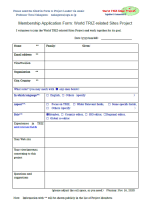
Membership application form (.docx) 
|
(2) List up Web sites related to TRIZ in each country (or in the specific methodology). 
First we should just list up known and recommendable TRIZ-related sites.
Show the list openly to the Team members and others for adding any sites.
Carry out Internet surveys to pick up some more sites not known widely.
|
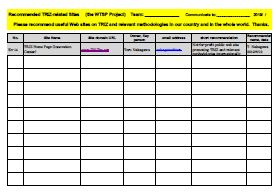
Template of List of sites 
|
(3) Describe the basic information and (brief/standard/close) introduction of each site. 
Basic information is the items to be used in the Index Table of sites.
(3a) For any site, a surveyor (a WTSP Member/Supporter or site owner) should describe a Brief introduction (3 - 10 lines) in a free format by actually visiting the site.
Starting at the page shown in the survey, visit its top page, 'About us' page, and some other main pages (quickly).
Internet search inside the site is often very useful.
For this purpose, you can use any Internet survey engine with site: oprator together with the search keyword. For example, use TRIZ OR "Systematic Innovation" site:www.triz-si.org as the keyword. (TN, May 23, 2021)
You may write in a relaxed format any items you understand (excerpts may be helpful).
Depending on the tentative evaluation of the site, you may describe the site closely
step by step.
|
(3b) Introduction in the WTSP Standard Form (1 page in A4) by the site owner. This is requested for all the sites in the World WTSP Catalogs.
Use the WTSP Standard Site Description Form (.docx)  and fill in all the cells. and fill in all the cells.
See the instructions shown below  . .
Several items at the top of this Form are the Basic Information of the site to be used in the 'Index Table' of the WTSP Catalogs.
Several items (Roles of site, Application phase, Application fields, and Methods) in the middle part of this Form are useful for categorizing the site in various aspects. Thus they are important for users to find some sort of sites quickly in the WTSP Catalogs. For answering to these questions, use the Code Tables  (in 'Multiple Sets of Indexing Schemes for the WTSP Catalog System') (in 'Multiple Sets of Indexing Schemes for the WTSP Catalog System')  and select suitable items in the order of importance/relevance for the specific site. and select suitable items in the order of importance/relevance for the specific site.
At the bottom part of this Form, Site Introduction should be written in a free format (of 5 - 10 lines).
The Site Description in this Standard Form is most important information of each site, and must be described by the site owner (or key-persons), because nobody else can describe it appropriately.
|
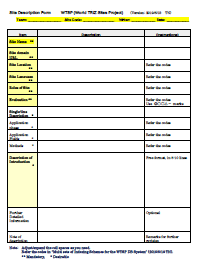
Standard Site Description Form |
(3c) Optional Close Introduction in free format (2 - 5 pages or more in A4) written by the site owner, in addition to (3b).
The one page description in the Standard Form is often not sufficient for users to understand the sites (especially in their uniqueness, importance, essence, etc.), and also too short for the site owners to describe their sites.
Since site owners are proud of their sites, they are welcome to write and show their site introduction fully (2 - 5 pages or more in A4) in free format in their own style of choice. See more instructions below  . .
See some examples, such as JP-01 (TRIZ Home Page in Japan) .
This Close Introduction is optional, but is much desirable for the sites with high evaluations. The Standard introduction (3b) is mandatory prior to this Close introduction (3c).
A separate file of (3c) is hyper-linked from the (3b)
form.
|
(4) Evaluate each site (tentatively). 
Use the following five grades of evaluation expressed with symbol marks. Instructions of evaluation criteria and of necessary considerations are shown below  .
.
To be shown in World WTSP Catalogs:
◎ Most important (about top 30)
○ Important (about top next 100)
□ Worthy of World Catalog
To be shown in Country WTSP Catalogs :
△ Worthy of Country Catalog (or Specific Methodology Catalog)
Not to be shown in WTSP catalogs:
― Irrelevant, no significance, etc.
(5) Make a Table ('Index Table') of sites with basic information for indexing. (.xlsx) 
Site name, Site domain URL, Site location, Site language (possibly multiple languages),
Roles of the site, Site evaluation (◎〇□△), Single line description, Manuscripts, Writer's name and date.
[Note (TN, 2020.11.19): This table was proposed first in April 2019, but is now renamed into 'Index Table' having some more general meaning.]
|
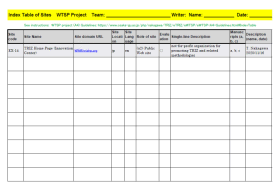
Template of
the Index Table of sites 
|
(6) Make these manuscripts (3) (5) open for review and revision in the country (or among the people interested in the methodology) 
(7) Convert these manuscripts into HTML pages, and Make Country/Methodology Part of WTSP Catalog. 
Attach a hyper-link at the Site Code in the Index Table, and the hyper-link must indicate
the anchor point placed at its site description in the Sites Description page.
Thus you have already built your Country/Methodology Part of WTSP Catalog as a small Web site.
Use a browser for testing the operations and hyper-links of your Country/Methodology WTSP Catalog.
|
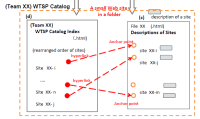
Structure of your
Country WTSP Catalog 
|
(8) Submit the completed manuscript of the Country/Methodology Part of WTSP Catalog (with the evaluation levels ◎〇□) to the Project Leader. 
(9) Review the World WTSP Catalogs and adjust/revise them if necessary. 
(B) Practice Guide for Enhancing the World WTSP Catalogs:
For individual owners (or key persons) of Attractive/Useful Sites 
(10) Site owners (or key-persons) of Attractive/Useful sites (at the levels ◎○□) are encouraged to describe their sites more closely in a free format (2 - 5 pages in A4). 
See (3c) above  .
.
(11) Submit the manuscripts (3b) and (3c) directly to the WTSP Project Leader. The information may be reflected in the WTSP Catalogs in the form of additional page in PDF attached to the site. 
The process (10)-(11) is a bypass of the ordinary process (3)-(8) in the Country Team (or SIG Group) for the purpose of encouraging quicker promotion of good and proactive sites.
(C) Some More Details of Guidelines 
(12) Handling Documents: Drafts, Manuscripts, Public Outputs 
Members, Country Editors, and Contributors (i.e.,non-Members) work to prepare Drafts, to refine them into Manuscripts, and to send the Manuscripts to the Project Leader.
Project Leader may send the Manuscripts (including ones prepared by himself) to people in or out of the Project for communication/reviewing, and make the
refined Manuscripts open to public in the WTSP site (inside "TRIZ Home Page in Japan") or some other places. Such Public Outputs may be interim/unofficial or final/official, and Project Leader is responsible (under the support of Global Co-editors) to society for the Public Outputs.
(13) Coding rules of countries, regions, etc. and Code Tables of Roles of sites, Application phases, Application fields, and Methods, etc. 
Use the 2-digit country code used for URLs. Regions are defined to group those countries.
Inside the World WTSP Catalog system, folders are hierarchically coded with Region and Country, but WTSP Members and users may not concern about such folder structures.
For describing Roles of sites, Application phases, Application fields, and Methods, etc. in the WTSP Standard Site Discretion Form, the Code Tables are prepared. These Codes need to be refined/updated along the progress of WTSP Catalogs.
(14) Handling documents written in non-English national languages 
Building Country WTSP Catalogs in the country's own (non-English) language is natural and useful for the people in the country. But they need to be translated into English for integrating into World WTSP Catalogs. Country WTSP Catalogs (in any language) should be managed in the country, WTSP Project Leader can not manage (non-English) WTSP Catalogs.
(15) World WTSP Catalogs of Around-TRIZ Sites 
World WTSP Catalogs have two pillars; one is for TRIZ Sites, and the other for Around-TRIZ Sites. The latter is already built in a reasonably good shape. Categorization of the sites with methodologies and application fields, etc. is an issue interesting but not achieved well yet.
(D) Note as a Future Image: Proposal of the WTSP Database System (May 24, 2019) 
On May 24, 2019 I made this proposal of building a Database System for building and operating our WTSP Catalogs in an advanced way. It proposes to use the database of site descriptions and to generate WTSP Catalogs in various ways of categorization. We have chosen, however, not to build such a software but to generate various World WTSP Catalogs practically by manual operation of the Index tables in Excel.
In future, we wish to install various functions mentioned in the DB proposal in some handy manners using the accumulated data of our WTSP Catalogs. For example, we wish to install a function for finding sites of specified categories among many sites in the World WTSP Catalogs.
 (A) Practice Guide for Building Country/Methodology Parts of the World WTSP Catalogs
(A) Practice Guide for Building Country/Methodology Parts of the World WTSP Catalogs
For Teams of countries and SIGs (Special Interest Groups) of various methodologies
 (1) Any person who understands the significance of the WTSP Project may voluntarily join WTSP as a member.
(1) Any person who understands the significance of the WTSP Project may voluntarily join WTSP as a member.
For joining the WTSP project, see the (A2) Organization page  .
.
If you volunteer to work together with us as a Member of WTSP, please fill in the Membership Application Form  and send it to the Project Leader, Toru Nakagawa nakagawa@ogu.ac.jp.
and send it to the Project Leader, Toru Nakagawa nakagawa@ogu.ac.jp.
If you wish to support or contribute to WTSP without becoming a Member, please send a short message to the WTSP Member(s) in your country (or a SIG) and to the Project Leader.
Getting active voluntary Members in the WTSP project is most crucial for the success of the WTSP project. See Section (12)  of the present page.
of the present page.
 (2) List up Web sites related to TRIZ in each country (or in the specific methodology).
(2) List up Web sites related to TRIZ in each country (or in the specific methodology).
You should list up good and important sites in your own country (or in some specific topic of your interest in the world). Since you are one of active users/practitioners of TRIZ (and related methodologies), you (and your friends) know some/most of such sites. Thus you should list them up from your memory, first of all, and ask your friends to enhance them.
For listing, you may use the template (.xlsx)  , having the following table structure:
, having the following table structure:
Recommended TRIZ-related Sites (the WTSP Project) Team: _____ Communicate to:______ 2020/ /
Please recommend useful Web sites on TRIZ and relevant methodologies in our country (and in the whole world). Thanks.
No. |
Site Name |
Site domain URL |
Owner, Key- persons |
email address |
short recommendation |
Recommender
name, date |
EX-14 |
TRIZ Home Page (Innovation Center) |
www.TRIZhp.org |
Toru Nakagawa |
nakagawa@xxx |
Not-for-profit public site for promoting TRIZ and relevant methodolgies internationally |
T. Nakagawa
2019/6/12 |
| |
|
|
|
|
|
|
| |
|
|
|
|
|
|
| |
|
|
|
|
|
|
Internet surveys are the secondary measures to be carried out to make a well-surveyed Catalogs of sites in your country or in your specific topic/methodology. Please note that Internet surveys are often very noisy. Experiences of Internet surveys are written in Nakagawa's WTSP documents.
 (3) Describe the basic information and (brief/standard/close) introduction of each site.
(3) Describe the basic information and (brief/standard/close) introduction of each site.
We use 4 levels of descriptions
(0) Basic information: Title part of (3a) = Initial 7 items of (3b) = Information used in Index Table.
(3a) Brief introduction: Free-format 3-10 lines, written by a surveyor. For all sites.
(3b) Standard introduction: Written in the Standard Form (1 page) by the site owner. Mandatory.
(3c) Close introduction: Optional free-format introduction (2 - 5 pages or more) written by the site owner.
(3a) For any site, a surveyor (a WTSP Member/Supporter or site owner) should describe a Brief introduction (3 - 10 lines) in a free format by actually visiting the site.
This brief introduction by a surveyor is usually the important initial step, before getting the Standard Site Introduction by the site owner.
Brief Introduction need to be composed of two parts:
Title part containing the Basic information (i.e., Site Name, Site domain URL, Site Location, Site Language, Roles of site, Evaluation, and Single-line Description) which is used later in the Index Table of sites (see (5)). The Title part is written in Bold face (in Blue).
Introduction part: written in a free format in 3 -10 (or 15) lines, based on the understanding by the surveyor
Starting at the page shown in the survey, visit its top page, 'About us' page, and some other main pages (quickly). You may write in a relaxed format any items you understand (excerpts may be helpful).
Internet search inside the site is often very useful.
Depending on the tentative evaluation of the site, you may describe the site closely
step by step.
Please refer to Nakagawa's experiences (such as
 ) and examples in the World WSP Catalogs.
) and examples in the World WSP Catalogs.
(3b) Introduction in the WTSP Standard Form (1 page in A4) by the site owner. This is requested for all the sites in the World WTSP Catalogs.
The Site Description in this Standard Form is most important information of each site, and must be described by the site owner (or key-persons), because nobody else can describe it appropriately.
Use the WTSP Standard Site Description Form (.docx)  and fill in all the cells.
and fill in all the cells.
For explaining the Form, I show the site description of my site JP-01 "TRIZ Home Page in Japan"  :
:
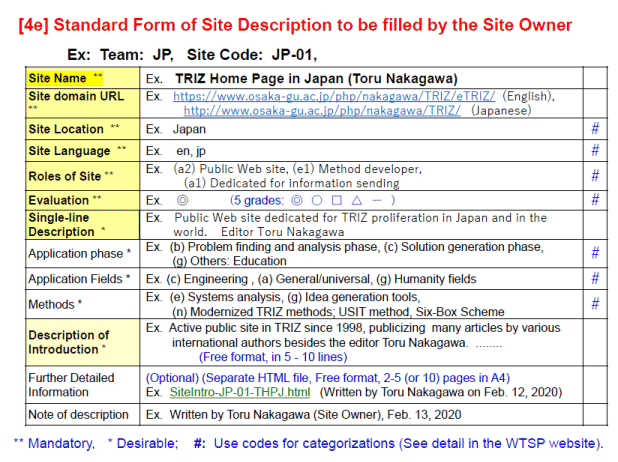
Team: Usually the 2-digit country code, e.g., JP, US, FR, etc. In case of SIGs, we will assign some 2-digit or 4-digit codes.
Site code: Assign a unique site code to each site, in the form XX-01, XX-02, etc. where XX is the Team code.
If the site is already shown in earlier WTSP Catalogs, use the same Site code as before. For example, JP-01, TN2A-04, etc.
Site Name: Name of the site. In case when an acronym or abbreviated form is often used, write it at first and then the full name next in ( ). For example: 'ETRIA (European TRIZ Association)' in stead of 'European TRIZ Association (ETRIA)'.
Site domain URL: Show the URL of the site domain, not URL of a page. (If the domain URL does not work, show the URL to a representative page.)
Site Location: Country of the site. Use 2-digit country code. If the site is operated in multiple countries, you may show those countries. The country shown first is regarded as the primary one.
Site Language: Show the language(s) either in 2-digit code (e.g., en, ru, etc.) or in word (e.g., English, Russian, etc.). You may show multiple languages.
Roles of site: Show the role(s) of the site using the indexing schemes shown in  . In addition to the code, write the name of the role category for avoiding possible confusion in future. You may show multiple roles, in the order of their importance for the site.
. In addition to the code, write the name of the role category for avoiding possible confusion in future. You may show multiple roles, in the order of their importance for the site.
For example: ETRIA: (b1) Dedicated association, (b3) International conferences;
Systematic Innovation: (e1) Method developers, (e4) Consultants, (a1) Dedicated for information sending, (f2) Publisher.
See various examples in the World WTSP Catalogs.
In the current World WTSP Catalogs, all sites are classified and rearranged in the order of the (primary) Role of site. Thus the information of Roles of site here is important for the World Catalogs.
Evaluation: Use a mark either ◎, ○, □, or △. See Section (4) 
Single-line Description: Short description of the site in free format. Max about 70 characters.
----- The items down to here are used in the Index Table of sites, See (4) below.
---- The following 3 items will be used in categorizing the sites. Answer them by using the Code Table in the page  . See also
. See also  .
.
Application phase: See the Code Table D. Along the the process of problem solving (in a general sense), the phase(s) of interests are to be shown here. Answers may be generic (in terms of main categories) or specific (in terms of sub-categories). The main categories are:
(a) General preparation phase, (b) Problem finding and analysis phase, (c) Solution generation phase, (d) Solution implementation phase, (e) Intellectual properties, (f) Business and market operation, (g) Others.
Application Fields: Fields of application are categorized here. Answers may be generic (in terms of main categories) or specific (in terms of sub-categories). Multiple answers need to be expected both in the main categories and in the sub-categories. In case of multiple answers, write most important ones (for the site) first. The main categories are:
(a) General/universal, (b) Science, (c) Engineering, (d) Biological and medical fields, (e) Business fields, (f) Social problems, (g) Humanity fields
Methods: Various methods to be applied in each stage of problem solving. Methods are listed here in generic terms instead of names of individual methods. Name of specific method may be inserted in ( ) after names of sub-categories.
Introduction: Free-format introduction to be written in about 5 - 10 lines. Assuming the existence of the description in other cells, introduce the site in its essence and special features, etc.
Further Detailed Information: Show the file name of the free-format close introduction which is optionally provided by the site owner. See (3c).
The file name should be coded as (for example: SiteIntro-JP-01-THPJ-200213.pdf): where
SiteIntro: fixed for indicating the (3c) file; JP-01: Site code in the form of XX-nn; THPJ : Simplified home page name, for avoiding future confusion; 200213 : date of registration in the form of yymmdd ; pdf: suffix of the file type PDF.
Keep blank if no close introduction (3c) is prepared.
Note of description: Writer's name and date of description, and any other note for update,
(3c) Optional Close Introduction in free format (2 - 5 pages or more in A4) written by the site owner, in addition to (3b).
The one page description in the Standard Form (3b) is often not sufficient for users to understand the sites (especially in their uniqueness, importance, essence, etc.), and also too short for the site owners to describe their sites.
Since site owners are proud of their sites, they are welcome to write and show their site introduction fully (2 - 5 pages or more in A4) in free format in their own style of choice.
[Note (TN, Nov. 19, 2020): Please submit the manuscript either in MS Word or in HTML; the accepted manuscript will be posted (later by the Project Leader) in the WTSP Catalogs either in PDF or in HTML.]
Here I show a sample of Close Description (in its outline form) of my site: JP-01 (TRIZ Home Page in Japan)  .
.

Since thee are various types of Website, this Close Introduction should be written in some appropriately style chosen differently for each site. Nevertheless, the initial part "(1) Features" may be widely applicable. The latter part, or the main body, would be quite different. I my case, since my site has over 1400 articles in Japanese and over 1100 articles in English, I have chosen to write brief explanation of selected 160 articles after categorizing them in the theme and along the history. Probably, corresponding to 'Roles of site' we may have different but typical style of Close Description of sites.
This Close Introduction is optional, but is much desirable for the sites with high evaluations. The Standard introduction (3b) is mandatory prior to this Close introduction (3c).
A separate file of (3c) is hyper-linked from the (3b)
Form.
 (4) Evaluate each site (tentatively).
(4) Evaluate each site (tentatively).
On the basis of understanding the contents of each site, you (either site owner or a WTSP Member) should evaluate the site even tentatively. The levels of evaluation are shown in five marks ◎○□△-, which are qualitatively stated as:
To be shown in World WTSP Catalogs: ◎ Most important (about top 30)
○ Important (about top next 100)
□ Worthy of World Catalog
To be shown in Country WTSP Catalogs : △ Worthy of Country Catalog (or Specific Methodology Catalog)
Not to be shown in WTSP catalogs: ― Irrelevant, no significance, etc.
Principal Criteria for evaluation may be stated qualitatively as:
Quality (reliable, correct, novel, original, comprehensive, up-to-date, ...)
Usefulness (resourceful, reference, handy, practical, ...)
Attractiveness (interesting, easy-to-understand, illustrative, ...)
Accessibility (open access, free/low charge, used by many, ...)
Scope (scope of the theme/field, scope of activities, ...)
With these aspects of evaluation criteria in mind, surveyors (WTSP Members or not) and site owners should evaluate individual sites faithfully, on the tentative evaluation basis.
Please note WTSP Catalogs have two pillars, i.e., WTSP Catalogs of TRIZ sites and WTSP Catalogs of Around-TRIZ sites. Individual sites should be evaluated from the viewpoints of either of these two categories separately. Since we already have World WTSP Catalogs of TRIZ sites and of Around-TRIZ sites, you may refer to them as sample cases for evaluation.
One important criterion is whether to show a site in both World and Country Catalogs or in Country Catalog alone. The criterion clearly comes from the intention of the World/Country Catalogs. Namely, Country WTSP Catalogs are intended for the people in the specific country, while World WTSP Catalogs are for the people in various countries in the world. The language of the site is a factor but not so important, because language translation can more or less overcome the demerit of non-English language. The target range of audience and activities may also be a factor but not crucial either, because contents of some sites may be valuable widely for the people in different countries. Values of the contents themselves, as shown in the Principal Criteria for evaluation, are the important factors.
The differences among the levels of ◎, ○, and □ are vague, saying ◎ about top 30 and ○ about top next 100, etc. Such levels may be reasonably well estimated by the site owners and by specialists in WTSP, if they have enough time to read and compare various sites. Unfortunately, however, there are too many sites and too many pages of articles in each site for such people to evaluate the levels of sites at reasonable confidence. Thus the site evaluations always have some ambiguity and errors. Sometimes, when we are unsure, we use double marks, such as '◎○' meaning '◎ or ○’. In these situations, we show the evaluation levels only 'tentatively' and 'roughly', because we believe such ’tentative and rough’ evaluation may be practically more useful than 'no evaluation'. See also  .
.
We will need, in near future, some ways to review and update the evaluations of individual sites. If you have any suggestions and recommendations, please communicate with Country Editor(s) ad the Project Leader.
 (5) Make a Table ('Index Table') of sites with basic information for indexing. (.xlsx)
(5) Make a Table ('Index Table') of sites with basic information for indexing. (.xlsx)
Use the template of the 'Index Table' of sites(.xlsx) down-loadable here  .
.
Index Table of Sites WTSP Project Team: _____ Writer: Name: _______ Date: _________
Site code |
Site Name |
Site domain URL |
Site Location |
Site Language |
Role of site |
Evaluation |
Single-line Description |
Manuscripts
(a, b, c)
|
Description
(name, date) |
| |
|
|
|
|
|
|
|
|
|
| |
|
|
|
|
|
|
|
|
|
| |
|
|
|
|
|
|
|
|
|
The information to be filled in this table for each site is a summary of information obtained in the processes (3) and (4)
and (4) .
.
The last 2 columns are unique in this table. They are;
Manuscripts: If the manuscripts (3a), (3b), and (3c) are ready, please write a, b, and c, respectively. (Updated: Nov. 16, 2020)
Description (name, date): Writer's name and date of description of the information for this site.
 (6) Make these manuscripts (3) (5) open for review and revision in the country (or among the people interested in the methodology).
(6) Make these manuscripts (3) (5) open for review and revision in the country (or among the people interested in the methodology).
This is the review and revision process inside the Team (or SIG group) or more openly inside the TRIZ community in the country or people interested in the topic.
Manuscripts (3) and (5) may be reviewed individually for each site or all the sites together.
Converting all the manuscripts in the form of a small Web site (in Process (7)) may be useful for the final review process.
Duplications of new sites with the sites already installed in the World WTSP Catalogs should be checked.
Country Teams are advised to
list up and describe their country's good sites, knowing such duplications, Arrange the sites in their country in a proper order, Assign Site-Codes suitable for their Country Catalogs, and Describe the Site Introductions (both by the surveyors and by the site owners) as much as possible, sometimes borrowing the descriptions in the existing Catalogs. In such a case of duplication, please mention the Site Code in the existing Catalogs and how you used/improved the site introductions. (In most cases the Site Code for the Country will be chosen prior to the Site Code set in the world Internet surveys.) --- See the Process (8) carried out by the Project Leader. (TN, Nov. 19, 2020).
 (7) Convert these manuscripts into HTML pages, and Make Country/Methodology Part of WTSP Catalog.
(7) Convert these manuscripts into HTML pages, and Make Country/Methodology Part of WTSP Catalog.
This is the final process for a Team. All the manuscripts prepared so far are integrated into a set of HTML pages in one folder and operable as a small Web site. The resultant Web site is a prototype of Country/Methodology WTSP Catalog and also a prototype of the Country/Methodology part of World WTSP Catalogs.
See the figure :
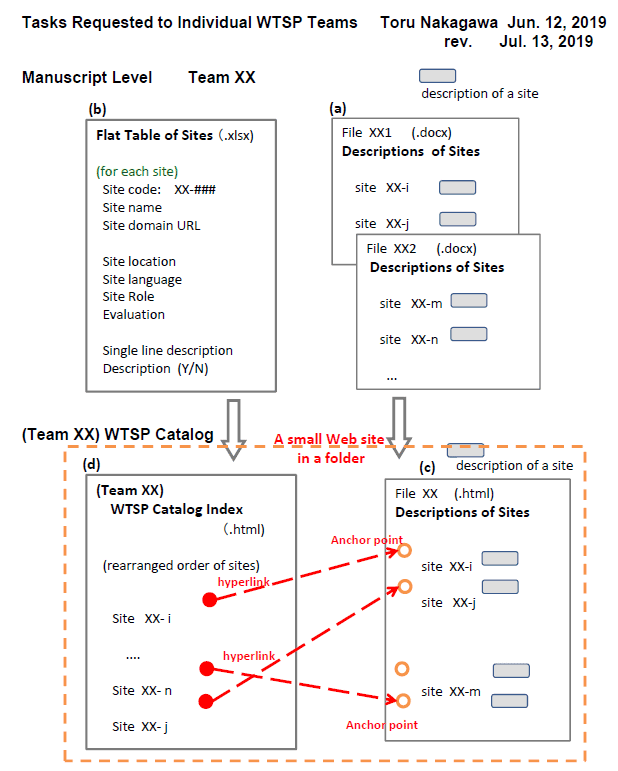
This process may be done as follows. (Getting some technical help may be desirable for you.)
- Prepare a new folder for setting the new Web site. (The folder name is arbitrary. Assume here as 'XX-WTSPCatalog')
- Prepare a Web page, named 'Sites-XX.html', for containing Description of Sites for all the individual sites together. See the examples in the current active World WTSP Catalogs. Converting .docx files into .html file is easy (by use of some software tools, in my case Adobe Dreamweaver). A whole table (like the one in the Standard Form of site description) may be copy & paste into the .html file without any particular operation.
- In the Sites-XX.html file, in front of each site description (XX-nn) an anchor (XX-nn) should be set. (Note: nn stands for a 2-digit number.)
- Prepare a second Web page, named 'Index-XX.html'. The 'Index Table of sites' in the .xlsx format should be converted into a table in the Index-XX.html file. (This conversion can also be done with a simple copy & paste operation from the .xlsx file to the .html file).
- In the 'Index-XX.html' file, onto the Site code of each site (XX-nn) in the table make a hyper-link addressed to the XX-nn site in the 'Sites-XX.html' file; the hyper-link should be 'Sites-XX.html#XX-nn'. Make such hyper-links for all the sites one by one. The ordering of sites in the Index-XX file may be different from the ordering in the Sites-XX file. Correspondence of all the Site codes in the Index-XX table, hyper-link, anchor, and the Sites-XX site description is crucial.
- If you have free-format Close Introduction (3c) files (i.e., 'SiteIntro-XX-nn-...-yymmdd.html' file or a .pdf file of the same name), include them in the same 'XX-WTSPCatalog' folder. Make sure in the Index-XX.html file that the file name in the column of Introduction should be turned into a hyper-link to the SiteIntro file.
- Using a browser software, make sure that every hyper-link works properly for viewing the site descriptions.
- In this manner, you now have built a Country WTSP Catalog (or XX WTSP Catalog).
- For making the XX Part of World WTSP Catalogs, you should check to include the sites with the evaluations of ◎, ○, or □ only.
Note: At moment it is difficult for the Project Leader to accept and handle Country WTSP Catalogs, made for the readers in the own country and written either in English or non-English language. Country WTSP Catalogs may contain Web sites of the levels ◎ ○ □ and △ (and even some important sites outside the own country). Please store and operate such Country WTSP Catalogs in your own sites.
 (8) Submit the completed manuscript of the Country/Methodology Part of WTSP Catalog (with the evaluation levels ◎〇□) to the Project Leader.
(8) Submit the completed manuscript of the Country/Methodology Part of WTSP Catalog (with the evaluation levels ◎〇□) to the Project Leader.
Now you should submit your manuscripts to the Project Leader, for the purpose of integrating them into the World WTSP Catalogs and of publicizing the results. Send the following files via email.
(a) Description of sites (in .docx) --- For subsidiary support of (c)
(b) Index Table of sites file (.xlsx) ---
(c) Description of Site file (.html)
(d) Catalog Index file (.html)
(e) Free-format Close Site Introduction
files (.html or .docx or .pdf)
The Project Leader will handle these files in the following way.
- The files (c)(d)(e) in the 'XX-WTSPCatalog' folder will be checked if they match the standard way of coding and if they work properly as a small Web site.
- The files (c)(d)(e) contained in the 'XX-WTSPCatalog' folder are installed inside the World WTSP Catalogs system, without any change except the change in the folder name and the folder location.
- The Excel file (c) of the Index Table of sites are integrated into much larger Index Table of sites containing all the sites in the world.
- Duplications of new sites with the sites already installed in the World WTSP Catalogs are checked. In case of a duplication, the Site Code more meaningful between the two is chosen. The contents of the Site Introduction data in the new manuscripts and the existing Catalogs need to be checked, and are selected or merged into a better Site Description. --- This process is rather tedious and should better be done in each Country Team (or SIG Group) beforehand. (TN, Nov. 19, 2020)
- On the Site code of every site (of the XX part), a hyper-link is set toward the Site description using relative pass of the folder.
- Then the whole Index Table containing all the WTSP sites in the world are sorted/rearranged in various ways to make multiple sets of World WTSP Indexes. This operation is done in a separate folder and never touches the folders containing the data of Index-XX and Sites-XX.
- The resultant World WTSP Indexes (in .xlsx) are converted into Web pages (in .html) to be used as the Indexes in the World WTSP Catalogs.
 (9) Review the World WTSP Catalogs and adjust/revise them if necessary.
(9) Review the World WTSP Catalogs and adjust/revise them if necessary.
A new version of the World WTSP Catalogs will be posted publicly in "TRIZ Home Page in Japan", (at least) every 3 months.
Please check the World WTSP Catalogs, especially its part of your manuscript. Please communicate with the Project Leader on any faults and issues to be considered and improved.
Revisions may be done either locally for individual minor changes or somewhat widely for remaking part of the Catalogs. If we need much larger revisions, such issues are announced or corrected at the minimal level and they may be corrected in the next version.
 (B) Practice Guide for Enhancing the World WTSP Catalogs
(B) Practice Guide for Enhancing the World WTSP Catalogs
For individual owners (or key-persons) of Attractive/Useful Sites
The processes so far in (A) (1) through (9) are based on the regular systematic approach. When you want to build WTSP Catalogs of your country or of some specific methodology/topic, you should use such processes.
Since we already built World WTSP Catalogs, we should better have another approach for enhancing them further without trying to rebuild them much. The process written below is such an effective shortcut for enhancing the Attractiveness and Usefulness of the World WTSP Catalogs. See  .
.
 (10) Site owners (or key-persons) of Attractive/Useful sites (at the levels ◎○□) are encouraged to describe their sites more closely in a free format (2 - 5 pages or more in A4).
(10) Site owners (or key-persons) of Attractive/Useful sites (at the levels ◎○□) are encouraged to describe their sites more closely in a free format (2 - 5 pages or more in A4).
It is recognized that the description of sites in the current World WTSP Catalogs are rather short for many important sites, which have many years of history, accumulations of original development of methodologies, various activities of proliferation and training, many cases of successful applications, many pages of papers, articles and essays, etc. Recommending good and useful sites is the primary purpose of our WTSP project. Thus we should better make larger opportunities for introducing good and useful sites. It may be the most practical way to encourage site owners to describe their own sites more closely in a free format, to appeal their sites Attractive and Useful to users/readers in the world.
As written in the process (A)(3)  , we have the option (3c) to introduce a site in a free format closely (about 2 - 5 pages or more in A4). Such description may be written best by the site owners themselves (instead of WTSP Members who are not directly involved in the sites).
, we have the option (3c) to introduce a site in a free format closely (about 2 - 5 pages or more in A4). Such description may be written best by the site owners themselves (instead of WTSP Members who are not directly involved in the sites).
Assume that such sites are described already in the single line for the Index and in the Standard Form of Site description (3b). The free-format description (3c) should be written in a fair and non-commercial attitude, of course, but does not have any other regulation.
Figures, photos, tables and hyper-links to important pages in the site are welcome.
 (11) Submit the manuscript directly to the WTSP Project Leader. The information may be reflected in the WTSP Catalogs in the form of additional page in PDF attached to the site.
(11) Submit the manuscript directly to the WTSP Project Leader. The information may be reflected in the WTSP Catalogs in the form of additional page in PDF attached to the site.
Site owners are invited to write Close Site Introduction (3c) and send it directly to the WTSP Project Leader at any time. (On reading the submitted manuscripts, Project Leader may sometimes suggest some revisions/enhancements, etc.)
[Note (TN, Nov. 19, 2020): Please submit the manuscript either in MS Word or in HTML; the accepted manuscript will be posted (by the Project Leader) in the WTSP Catalogs either in PDF or in HTML
The Close Introduction page is installed in the 'XX-WTSPCatalog' folder (with the file name: 'SiteIntro-XX-nn-...-yymmdd.html' or .pdf), and in the Index-XX.html page a hyper-link to it is added in the 'Introduction' cell of the site. This updating is quite simple and will be done by the Project Leader, as quickly as possible.
Additional announcement will be made in the "TRIZ Home Page in Japan" for introducing the site.
 (C) Some More Details of Guidelines
(C) Some More Details of Guidelines
 (12) Handling Documents: Drafts, Manuscripts, Public Outputs
(12) Handling Documents: Drafts, Manuscripts, Public Outputs
In our previous Guideline, we discussed the stages of documentation and process of authorizing the outputs, in a rather formal manner. However, reflecting our experiences for these 3 years, I would like to set relaxed and simpler ways of handling.
(1) Members, SIG Editors, Country Editors, and Contributers (i.e., non Members) prepare their documents at the Drafts level and refine them (by reviewing inside the Team/SIG or some more widely) to the Manuscript level. And they may send their Manuscripts to the WTSP Project Leader.
(2) Project Leader may send Manuscripts (made in (1) or by Project Leader himself) to various people inside or outside the Project for internal (not open) reviewing/discussion. Project Leader may open the documents publicly (i.e., as the Public Outputs) in the Web site "TRIZ Home Page in Japan" or any other suitable places/forms. Public Outputs may be sometimes interim/unofficial for further revisions and sometimes final/official (such as conference papers); in all the cases Project Leader is responsible (under the support by the Global Co-editors) to society for the Public Outputs.
 (13) Coding rules of countries, regions, etc. and Code Tables of Roles of sites, Application phases, Application fields, and Methods, etc.
(13) Coding rules of countries, regions, etc. and Code Tables of Roles of sites, Application phases, Application fields, and Methods, etc.
For representing countries, we use the 2-digit country codes for expressing URL (See detail in Wikipedia  ). And countries are grouped into Regions as shown in the following table. Some other codes may be used for the hierarchical structuring of folders in the WTSP Catalog system.
). And countries are grouped into Regions as shown in the following table. Some other codes may be used for the hierarchical structuring of folders in the WTSP Catalog system.
Region code |
Region name |
Countries (a part) shown in their Country codes |
A |
Europe |
at be ch cz de dk ee es fi fr gr hu ie it nl no pl pt ro se sk uk yu |
B |
Russia and ex-USSR |
az by md ru ua |
C |
Middle East |
il ir jo lb ps sa tr |
D |
Asia |
cn hk id in jp kr my ph pk sg th tw vn |
E |
Oceania |
au nz |
F |
North America |
ca us |
G |
Central and South America |
ar br cl mx ni |
H |
Africa |
eg ma za |
| I |
Others |
|
In the World WTSP Catalogs system (posted in "TRIZ Home Page in Japan"), various Manuscripts submitted by individual Teams (i.e., usually from each country) are stored in a hierarchical folder system (currently each folder for a country is coded as [Region code]-[Country code]-[Country name]).
But WTSP Members (or WTSP users) do not need to think about the folder system at all.
WTSP Teams should keep the rule of the file name using the Team (or Country) code XX:
Index file (.html) Index-XX.html
Sites Description file (.html) Sites-XX.html
Note (Jun. 30, 2020) Various cases of Top-down surveys of TRIZ sites or Around-TRIZ sites are given 4-digit codes (in a rather ad-hoc manner, e.g. TN2A, TN3B, X1BZ, etc.) in place of [Region]-[Country] code. Folders of such cases are also stored in the 'eWTSP-WorldCatalog' folder together with the folders coming form various countries.
---------------------
In addition to the Code Rule of Countries and Regions described ablove, Code Rules for categorizing the sites are defined fully in the page 'Multiple Sets of Indexing Schemes for the WTSP Catalog System'  . The page was originally posted in May 24, 2019 as a part of the proposal of the 'WTSP Database System' (See (D) below
. The page was originally posted in May 24, 2019 as a part of the proposal of the 'WTSP Database System' (See (D) below  ). Even though the DB software system was not chosen, the idea of categorizing all the sites in multiple aspects was adopted just as proposed. The page describes the following aspects of categorization and shows systems of possible responses in hierarchies of categories and sub-categories.
). Even though the DB software system was not chosen, the idea of categorizing all the sites in multiple aspects was adopted just as proposed. The page describes the following aspects of categorization and shows systems of possible responses in hierarchies of categories and sub-categories.
A. Location (Site Location) 
B. Language (Site description language) 
C. Roles (Roles of the site or the site owner) 
D. Application phases (along the problem solving)  ,
,
E. Application fields 
F. Methods 
X. Evaluation 
Please refer the page for the detail.
 (14) Handling documents written in non-English national languages
(14) Handling documents written in non-English national languages
As shown in the (A1) Policy page , we understand well the importance of usage of national (English or non-English) languages. In many non-English speaking countries in the world, Web sites are often written in their own non-English languages. Hence it is natural and useful to write your Country WTSP Catalogs in your own language for your people in your country, and translate it (after selecting sites) into English to show in the World WTSP Catalogs for the people in the world.
At present, the Project Leader can handle the World WTSP Catalogs alone. He can not manage various Country WTSP Catalogs (written in English or non-English language), due to the limit in his time capacity. Please manage them in your own countries. All the Guidelines written here may be essentially applicable when you prepare your Country WTSP Catalogs in you own national language, I hope. (See some more in the old page of (A4) Guidelines  .)
.)
Most parts of Guidelines concern with the documents written in English, if not explicitly mentioned otherwise. Since there are many good Web sites written in non-English languages, they also should be introduced in English for people in the world.
 (15) World WTSP Catalogs of Around-TRIZ Sites
(15) World WTSP Catalogs of Around-TRIZ Sites
For building the World WTSP Catalogs of 'TRIZ-related' Web Sites, we have chosen to build two pillars, one for TRIZ Sites and the other for Around-TRIZ Site. These 2 pillars are already built well in our (Preliminary Edition Oct. 2019 and) Beta Edition (Jun. 2020).  .
.
The World WTSP Catalog of Around-TRIZ Sites was built on the basis of Internet surveys using several sets of key words. The keywords refer relevant fields/issues in general and not any specific methodology. By visiting the sites one by one, introductions to them are described by using their top pages, 'About us' pages, and some more main pages. The sites are grouped according to the surveys (i.e., key words for surveys) and categorized and rearranged with the Roles of sites. Thus the sites of various methodologies are shown together without explicit classification.
Note (TN, Nov. 19, 2020): Categorization of sites according to their fields of application and their methods may be of much interest for readers/users. Our WTSP Standard Form of Site Description requests the site owners to write about Application phase, Application fields, and Methods, by using hierarchically sets of categories and allowing multiple answers in the order of importance for the sites. These answers should be very valuable information for the users to search for the sites of their various interests. In addition to the preset terms of categories/sub-categories expressed in general terms, site owners may write in specific terms (of names of specific methods, in particular). Hope these information works effectively. (See (D) also.)
 (D) Note as a Future Image: Proposal of the WTSP Database System (May 24, 2019)
(D) Note as a Future Image: Proposal of the WTSP Database System (May 24, 2019)
On May 24, 2019, Nakagawa posted "Proposal of the WTSP Database System"  . The proposal was not taken for installation from a practical viewpoint, but it is recorded here as a basis for future consideration.
. The proposal was not taken for installation from a practical viewpoint, but it is recorded here as a basis for future consideration.
Proposed system is represented well in the following figure:
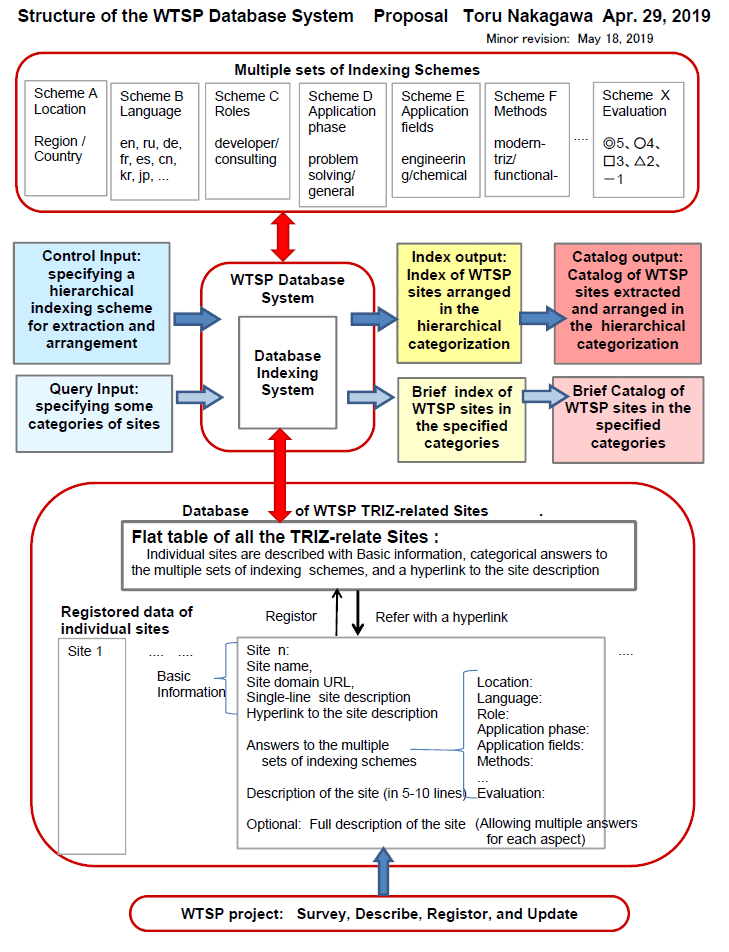
Many sites are described in a standardized manner and stored as a database having a 'Index Table' of sites for indexing. [Note (TN, Nov. 19, 2020): In the figure, the word 'Flat Table' is used in place of 'Index Table'.]The system allows flexible and powerful categorization/sorting by use of multiple sets of indexing schemes, where each scheme (or aspect) of indexing allows multiple answers for a site (e.g., multiple locations, multiple languages, multiple roles, etc.). The WTSP Database system accepts various requests of catalog generations and site retrievals and generate the results (such as a customized World WTSP Catalog) by full/flexible use of the multiple sets of indexing schemes.
This proposal was not chosen (in Jun. 2019) because of the difficulties that it assumes much standardized and full description of many sites and that it requires adaptive and powerful categorization algorithms for handling the multiple set and multiple answer data items. From the practical consideration, we have chosen the manual operations for handling many not-well standardized data of sites and for categorizing and sorting the sites in various ways for different Catalogs. Such a practical choice has lead us achieve the Preliminary version of World WTSP Catalogs within a few months (in Aug. 2019).
We now have built the World WTSP Catalogs of TRIZ Sites and Around-TRIZ Sites, and expect the growth of the Catalogs. Manual handling for generating World Indexes will become scaled up gradually. Moreover, it may become difficult for users/readers to find some sites most suitable for their own interest from the World WTSP Catalogs recording several hundreds of sites. -- We wish to overcome these difficulties in the near future in some new and yet practical way. I am thinking that the preceding Proposal may give us a hint. This is the reason why I put this Note here.
Last updated on Mar. 22, 2023. Access point: Editor: nakagawa@ogu.ac.jp


(Mar. 31, 2020)







